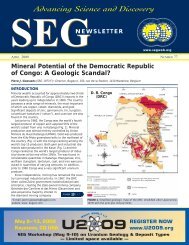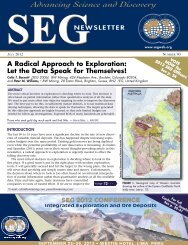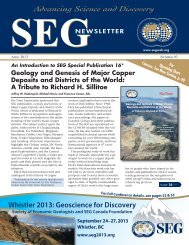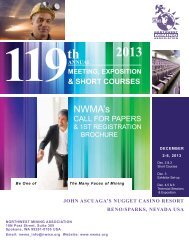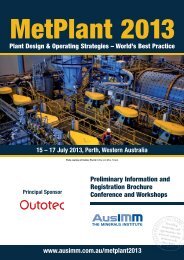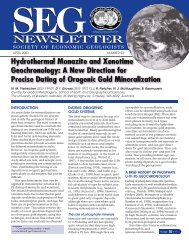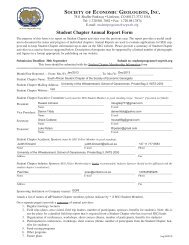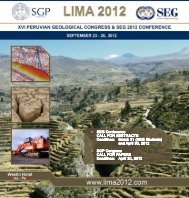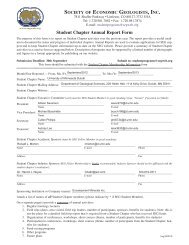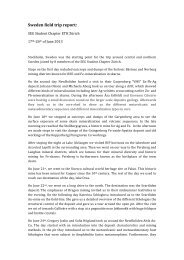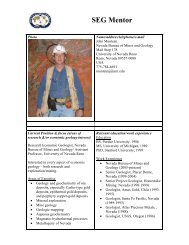SEG 45 Final_qx4 - Society of Economic Geologists
SEG 45 Final_qx4 - Society of Economic Geologists
SEG 45 Final_qx4 - Society of Economic Geologists
Create successful ePaper yourself
Turn your PDF publications into a flip-book with our unique Google optimized e-Paper software.
28 <strong>SEG</strong> NEWSLETTER No 55 • OCTOBER 2003<br />
... from 27<br />
Exploration Reviews (Continued)<br />
EXPLORATION REVIEWS<br />
Geologix Explorations completed<br />
initial exploration at its Macomb gold<br />
prospect in northern Alaska Range.<br />
Drill targets were selected based on geophysical<br />
work and gold in soil geochemical<br />
anomalies. Three diamond drill<br />
holes were unable to penetrate the<br />
glacial till overburden which is at least<br />
120-m thick. A fourth drill hole tested a<br />
lower priority target and indicated sporadic<br />
low level gold values scattered<br />
throughout a 15-m-wide altered and<br />
faulted structural zone.<br />
AngloGold USA and partner Rimfire<br />
Minerals began work on their ER and<br />
Eagle gold projects in the Goodpaster district.<br />
Work at ER is designed to drill test a<br />
1,500 ¥ 300 m gold-arsenic-bismuth-antimony<br />
soil anomaly outlined in 2002. The<br />
anomaly is coincident with a structural<br />
contact between gneissic country rock<br />
and a Cretaceous intrusive. Work at<br />
Eagle will consist <strong>of</strong> additional soil auger<br />
sampling to expand a 1,500 ¥ 3,000 m<br />
soil anomaly that also appears to be<br />
related to the contact between gneissic<br />
country rock and younger intrusives.<br />
ALASKA RANGE<br />
Nevada Star Resources acquired the<br />
Summit Hill prospect on its MAN<br />
copper-nickel-platinum group element<br />
project in the central Alaska Range.<br />
These claims were staked to cover a<br />
strong annular magnetic anomaly <strong>of</strong><br />
PAID ADVERTISEMENT<br />
approximately 7 miles diameter. The<br />
anomaly was identified by an airborne<br />
magnetic survey recently released by the<br />
Alaska Division <strong>of</strong> Geological and<br />
Geophysical Surveys. Limited sampling<br />
from a magnetite-rich showing within<br />
the area <strong>of</strong> the anomaly returned 1.58%<br />
nickel, 1.07% copper, 300 ppb platinum,<br />
484 ppb palladium and 110 ppb gold.<br />
The company believes that the anomaly<br />
is caused by mafic to ultramafic gabbro<br />
and pyroxenite that are cut by a<br />
granitic intrusion that is reflected by the<br />
nonmagnetic core <strong>of</strong> the anomaly.<br />
There is potential for metal enrichment<br />
within the mafic rocks adjacent to the<br />
contact zone in the area <strong>of</strong> the strongest<br />
magnetic zone. Plans for the new claims<br />
include prospecting, mapping and geochemical<br />
sampling, followed by geophysical<br />
surveys and drilling. The company<br />
also announced start-up <strong>of</strong> phase<br />
two work on its MAN copper-nickel-platinum<br />
group element property in the<br />
central Alaska Range. The planned<br />
August-September program was slated<br />
at $1.25 million and will be focused on<br />
their Canwell and Rainy prospects.<br />
Golconda Resources began drilling<br />
on their Shulin Lake diamond project<br />
west <strong>of</strong> Talkeetna. Drilling will test a 1.5-<br />
km diameter circular topographic feature<br />
that could represent a volcanic center<br />
related to the mantle-derived<br />
diamond indicator minerals found in<br />
previously collected surface samples.<br />
Previous drilling <strong>of</strong> 15 holes intersected a<br />
mixture <strong>of</strong> sandy material derived from<br />
the Alaska Range and volcanic material<br />
derived from a nearby source. Lab results<br />
showed the existence <strong>of</strong> indicator minerals<br />
in these rocks and one interval from<br />
hole 10 contained 16 micro diamonds.<br />
The 60 th anniversary <strong>of</strong> Usibelli Coal<br />
Mines was celebrated in late July at an<br />
open house at the company’s mine site<br />
near Healy. Upward <strong>of</strong> 1,500 people<br />
showed up for the event which included<br />
dedication <strong>of</strong> the newly opened Two<br />
Bull Ridge open pit and a chance for<br />
visitors to watch the Ace in the Hole<br />
dragline and other heavy equipment<br />
working in the pit. The hosts were wonderful,<br />
the occasion auspicious and the<br />
rain let up long enough to make the<br />
entire day enjoyable. Thanks UCM!<br />
NORTHERN ALASKA<br />
Little Squaw Gold Mining Co., a venerable<br />
name in Alaska’s lode mining<br />
history, has taken on a new life under<br />
new management and looks to become<br />
more active in the future. The quartz<br />
lodes were last worked from 1979 to<br />
1983, when 8,169 oz <strong>of</strong> gold was recovered<br />
from 11,819 tons averaging 0.97 oz<br />
Au/ton. Gold is hosted in mesothermal<br />
quartz veins along four major eastwest–striking<br />
shear zones that cut<br />
Paleozoic age quartz-mica schist and<br />
calcareous schist. Individual structures,<br />
known as the Mikado, Summit, Little<br />
Squaw and Envelope, are 2 to 5 miles<br />
long and frequently extend over 100 ft<br />
in width. Plans are being formulated for<br />
future work by the company’s new<br />
management team consisting <strong>of</strong> names<br />
that are welcome and familiar here in<br />
Alaska: Dick Walters, Jackie Smith,<br />
Jim Duff and Riz Bigelow.<br />
SOUTHEAST ALASKA<br />
Kennecott (70.3%) and Hecla (29.7%)<br />
announced 2nd quarter 2003 production<br />
from the Greens Creek mine on<br />
Admiralty Island. The total cash cost/oz<br />
<strong>of</strong> silver at Greens Creek for the quarter<br />
was $1.00, a forty-five cent/oz decrease<br />
compared to the 2nd quarter <strong>of</strong> 2002.<br />
The average grade <strong>of</strong> ore mined during<br />
the quarter was 19.11 oz/ton, down<br />
slightly from the 20.07 oz <strong>of</strong> silver per<br />
ton averaged in the same period in<br />
2002. During the second quarter the<br />
mine produced 2,800,891 oz <strong>of</strong> silver,<br />
27,268 oz <strong>of</strong> gold, 7,144 tons <strong>of</strong> lead<br />
and 22,657 tons <strong>of</strong> zinc. Total production<br />
costs for the quarter were $3.66/oz<br />
<strong>of</strong> silver produced, a significant<br />
decrease over year previous figures.<br />
Coeur d’Alene Mines signed a memorandum<br />
that should speed development<br />
and reduce regulatory costs at its<br />
Kensington deposit north <strong>of</strong> Juneau.<br />
Signers <strong>of</strong> the agreement were the Alaska<br />
Department <strong>of</strong> Natural Resources, U.S.<br />
Forest Service, U.S. Environmental<br />
Protection Agency, and Army Corps <strong>of</strong><br />
Engineers and outlines roles and responsibilities<br />
<strong>of</strong> the agencies with respect to<br />
the project’s final Supplemental<br />
Environmental Impact Statement. The<br />
company anticipates receiving all necessary<br />
permits for Kensington by the end<br />
<strong>of</strong> January 2004, and plans to reach a<br />
final decision on developing the mine<br />
after completion <strong>of</strong> the permitting and a<br />
feasibility study update.<br />
Pacific North West Capital and JV<br />
partners Freegold Ventures and



